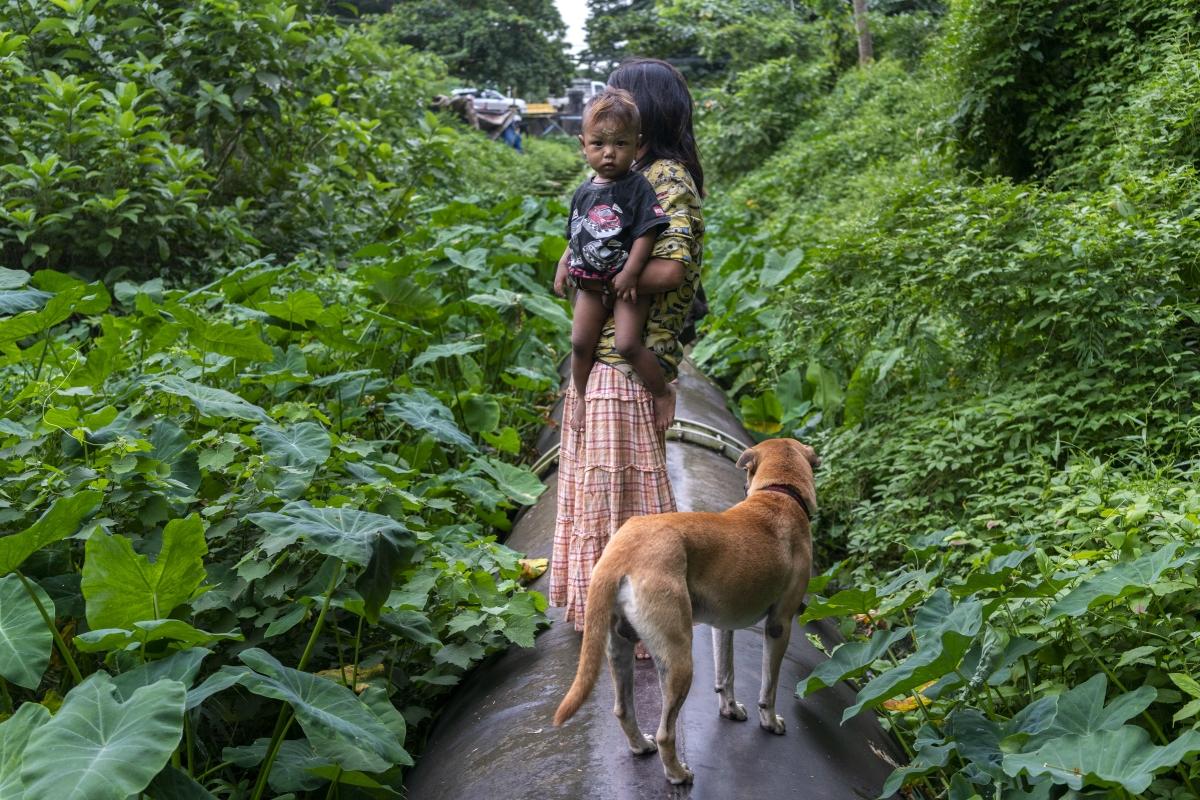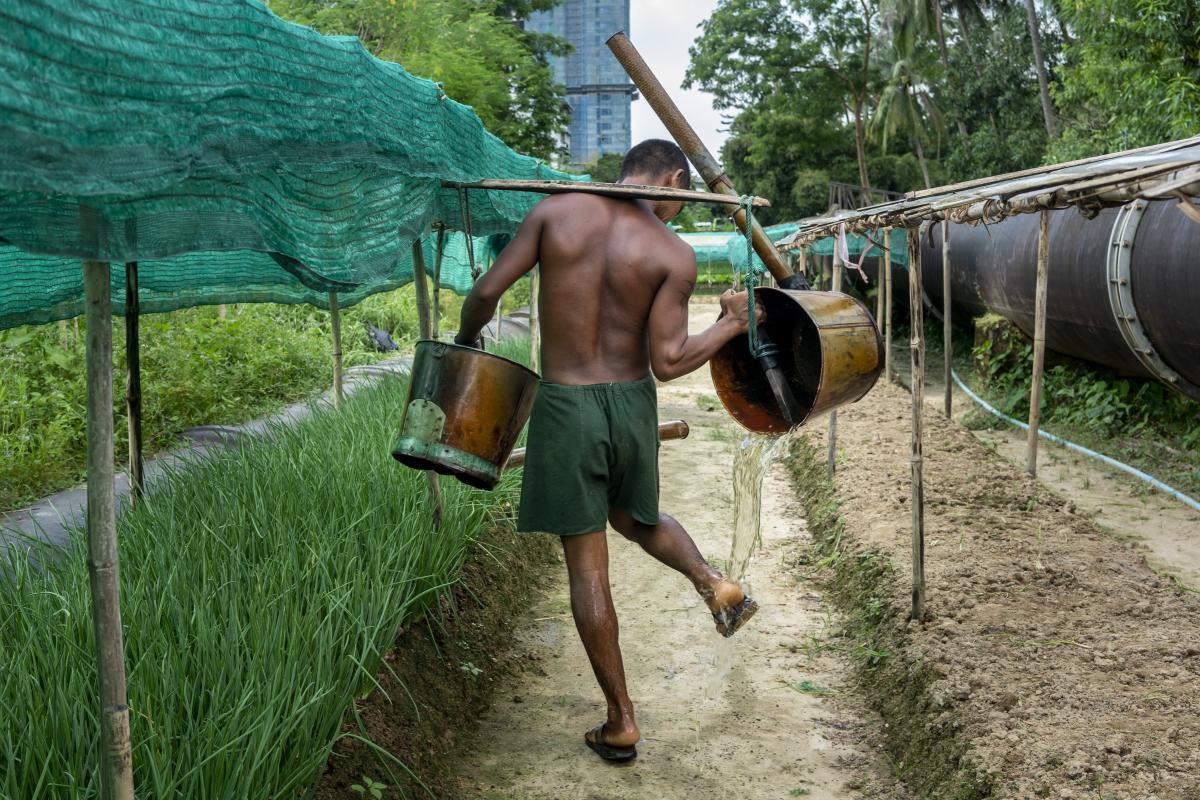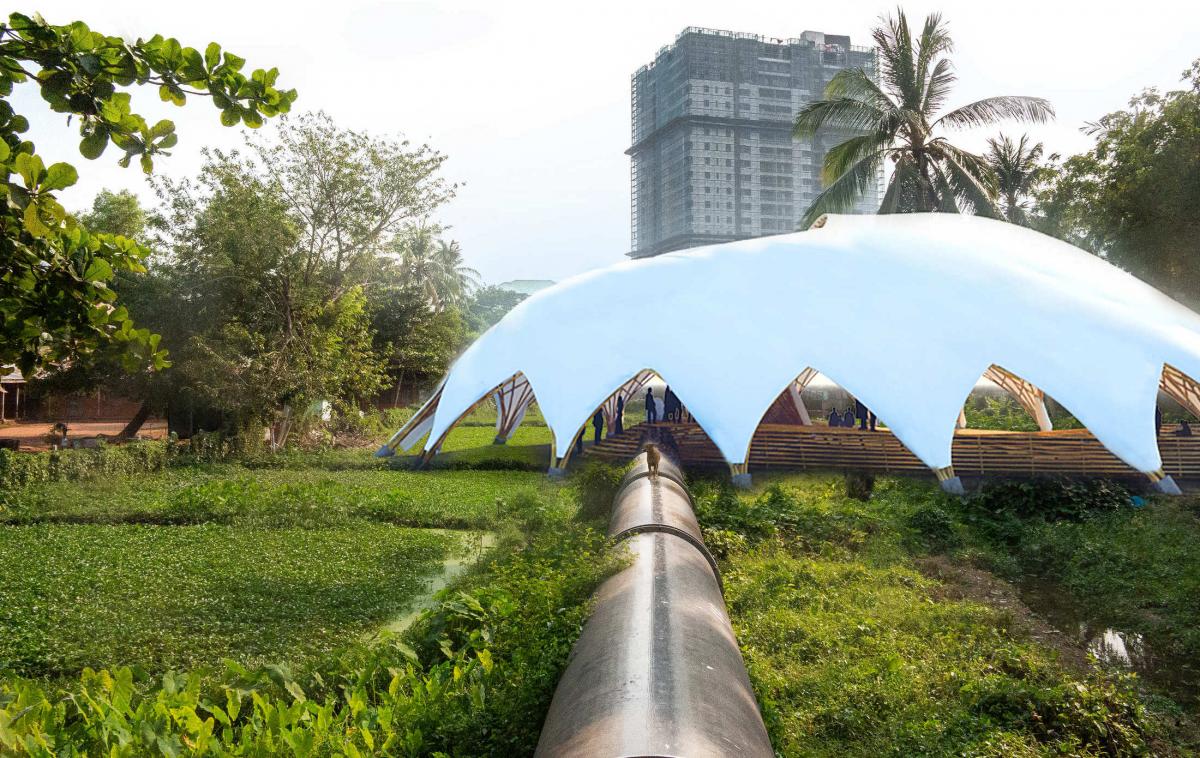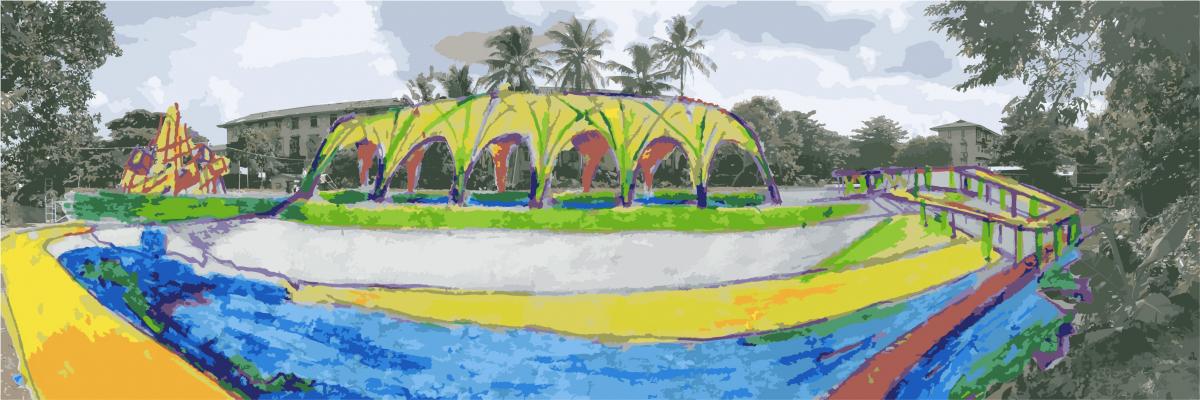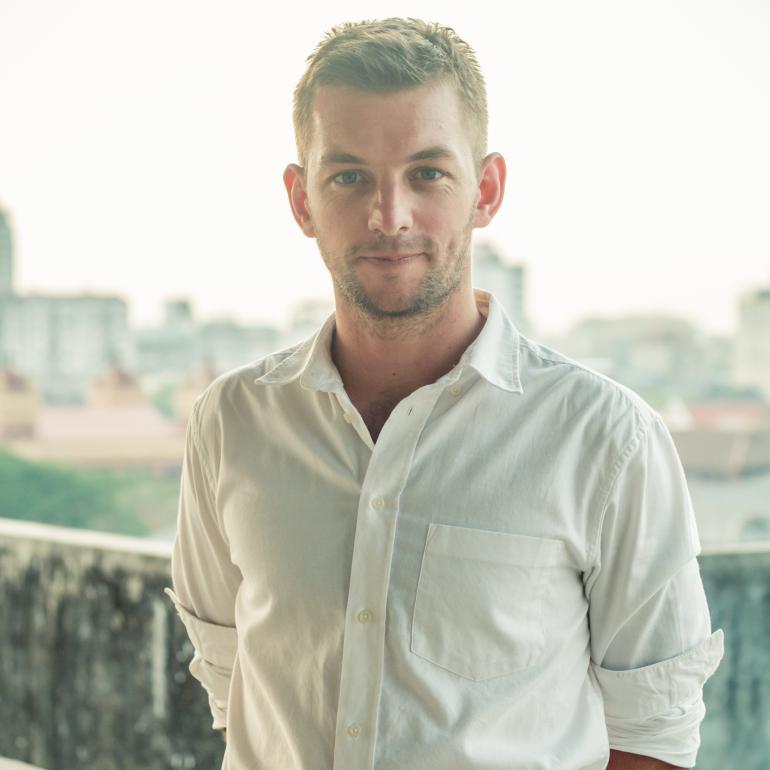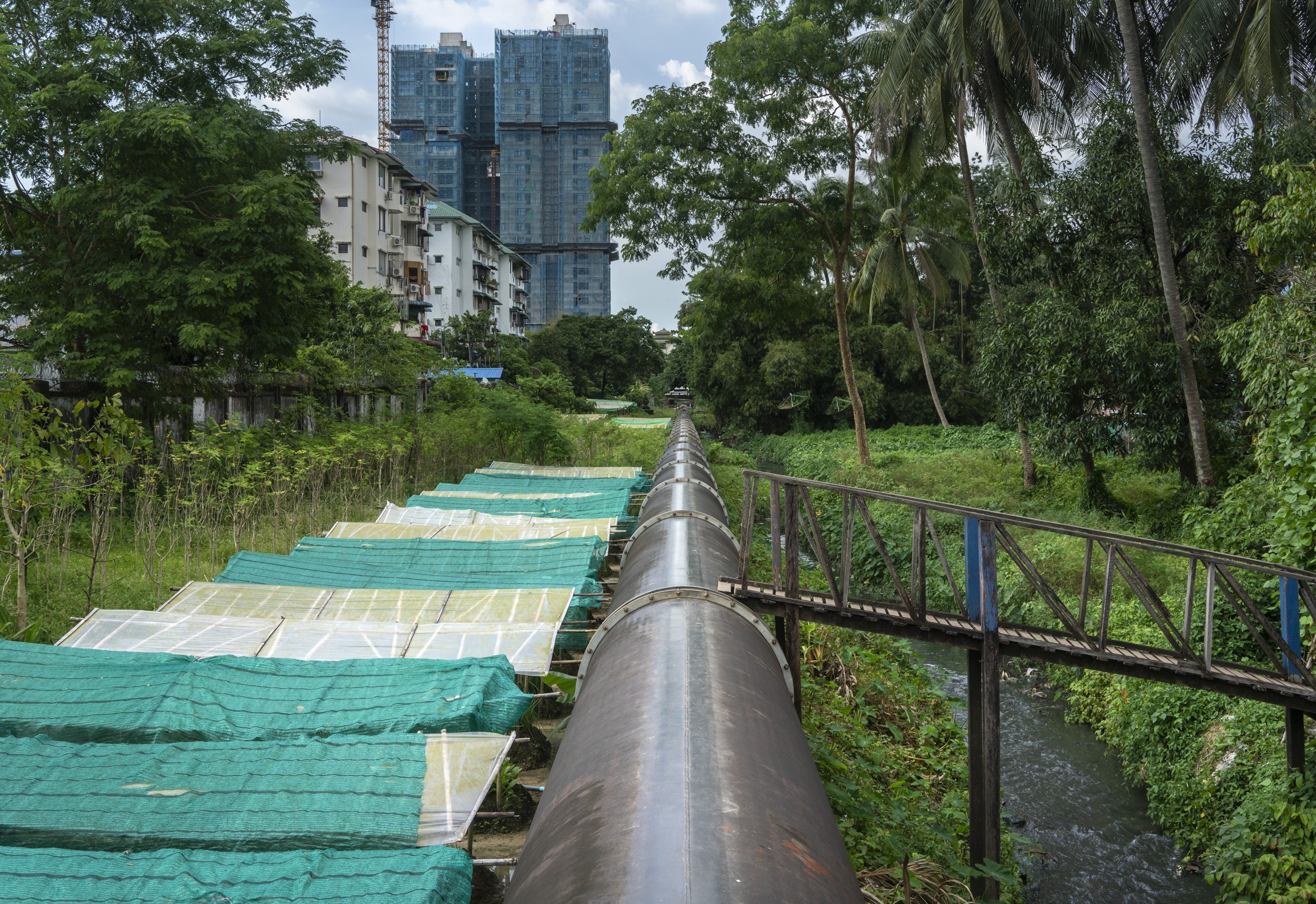
Pythons, parakeets and an elephant camp surround Gyo Phyu pipeline as it emerges from a reservoir amid lush countryside 63 kilometres north of Yangon.
Villages soon present themselves; clothes dry and people wash over the pipe’s warm steel. Gaps between villages shorten, until the line becomes a footpath shaded by overhanging trees through busy townships, a more enjoyable walkway than the clogged asphalt nearby.
One of the city’s main water supplies for 80 years, the pipeline nears its end in Yankin township, where plans are afoot to build a market, playground, community garden, resting place, sports field and floating decks with trash-catching nets.
Three common threads run through these projects: bamboo, an architectural team and, of course, the pipeline, which connects them all.
“It’s an opportunity to create a green corridor that joins the whole city together,” says architect Raphael Monnier, 27, who has lead the development since he became smitten with the tube three years ago.
Children take their first steps on a narrow, dark streak peppered with dusty footprints atop its cylinder. It becomes their elevated path to school, a setting for first dates, a lunchtime hangout for workers—the bravest even ride their bicycles along the streak, though hopefully not after boozing at a local beer station, named the Big Pipeline.
Eight metres flanking the channel on each side was reserved but rarely used for maintenance. In this buffer zone, communities have built bridges crossing the structure and farmed onions or watercress. Some squatter families moved in decades ago, creating barbershops and a playground borne from recyclable materials.
Despite their contributions, which include collecting oxygen bottles for local hospitals, distributing water and picking trash, eviction is an ever-looming threat for squatters.
Monnier, a co-owner of Yangon-based architecture and design company Blue Temple, believes the projects will bring more security and opportunities to these families.
On a recent evening, he talked me through the plan, which was inspired by the High Line, a park built atop a former rail trestle in New York that runs for 2.33 kilometres. This pipeline could be developed into a narrow park seven kilometres longer, from Yankin to Yangon airport.
But for now the focus is on a cluster of projects: one has been completed, another needs funds, and another needs funds and approval. Having returned that day from “milestone” meetings with local government figures, Monnier says the chance of getting permission have “boosted a lot.”
Local approval is high, he says: young people yearn for more green spaces enjoyed by the likes of Singapore, while older people reminisce about a time when Yangon was full of them.
Workshops with Myanmar students have contributed ideas, and Kyaw Zin Latt, 31, of bamboo firm Monkey Joint, is leading construction.
“I really like these pipeline projects,” Kyaw Zin Latt tells me over the phone. “They are all for local people. Poor people live in slums on the pipeline too, and if we are successful, these structures will improve their lives.”
Currently building sustainable bamboo homes for low-income families in Bago, Kyaw Zin Latt sees the fast-growing C02-absorbing plant as a part-solution to deforestation in Myanmar—as well as the ‘green steel’ that will liberate us from Yangon’s concrete jungle.
Bamboo park
School children were the first to benefit from the initiative.
Near the back of a Yankin middle school, a bamboo mat ribbons six metres into the air, reaching over the pipeline before swerving back down to earth.
Built earlier this year by Monkey Joint using a US$6,300 grant from Hong Kong charity Design Trust, the playground also features tyre swings, monkey bars, swinging ropes and nets.
Children who helped paint the space sit down on the flower-shaped footings for lunch. At night, solar-powered lighting follows the curves of the bamboo mat, illuminating the pipeline underneath.
Parts of the pipeline had become a magnet for drug users at night, says Monnier, but this romantic lighting has transformed the section into something of a lovers’ lane.
“In urban planning there are many ways to make places safe,” says Monnier. “The most stupid is by creating a wall, which is counter productive, but if you use nature and lighting you make a place safer.”
Farmers’ market
A two-minute walk from the school, Monnier has proposed another bamboo structure—a roughly 11-metre high shell stretching over the pipeline under which urban farmers would sell their produce.
We stand single-file on the pipeline, leaving just enough room for a teenager to squeeze past. In Monnier's hand is a 3D model of the design—designed by professor Kristof Crolla of the Chinese University of Hong Kong, printed in mainland China and sent to Yangon. For him, the model represents a collaboration that goes beyond Myanmar’s borders.
The shell is a parametric design, which allows a computer to generate form from a set of coding. Farmers could tend small gardens and hold agricultural lessons for local students underneath the covering, which would be coated in water and sunshine resistant fibreglass, says Monnier. At night, the public space would also light up.
If Yangon City Development Committee gave him the green light today, Monnier estimates he would need six months to secure about $50,000 funding and three months to build the structure.
Bamboo village
"When I saw this, it was like a dream come true," says Monnier, pointing to a large green mound sloping towards a 10-metre drainage system connected to the pipeline.
Local politicians gave Blue Temple the go-ahead for this site, explains the architect, who must now raise funds to develop it.
"Building a bamboo public space on this massive scale in Yangon is incredible," he adds. "It does not happen every day."
Over the drainage system would be a floating deck with fishing nets for catching plastic bottles and other rubbish that clogs the water. From the deck, two ramps would lead to a community farm set next to a bamboo shell, where public gatherings as well as football and chinlone matches would take place.
Finally, a structure inspired by bamboo scaffolding used to renovate pagodas would house a traditional zayat, or resting place, and a playground.
The whole 'village' would cost about $40,000, says Monnier. With the success of the bamboo park and a steely commitment to the development, he sees it all falling into place.

